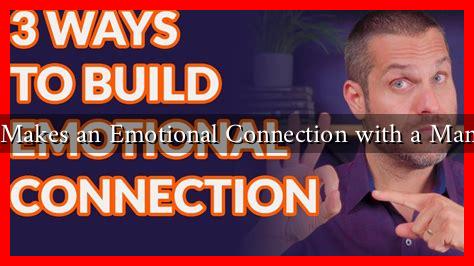-
Table of Contents
What Makes an Emotional Connection with a Man Last?
Emotional connections are the bedrock of lasting relationships. They foster intimacy, trust, and understanding, which are essential for a healthy partnership. But what exactly makes an emotional connection with a man endure over time? This article delves into the key factors that contribute to a lasting emotional bond, supported by research, examples, and expert insights.
The Importance of Communication
Effective communication is the cornerstone of any strong relationship. It allows partners to express their feelings, needs, and concerns openly. According to a study published in the Journal of Marriage and Family, couples who communicate effectively are more likely to report higher levels of satisfaction in their relationships.
- Active Listening: Men often appreciate when their partners listen without judgment. This creates a safe space for them to share their thoughts and feelings.
- Expressing Vulnerability: Sharing fears and insecurities can deepen emotional intimacy. When a man sees that his partner is willing to be vulnerable, it encourages him to do the same.
- Regular Check-ins: Establishing a routine for discussing feelings can help maintain emotional closeness. This could be a weekly date night or a simple daily check-in.
Building Trust Through Consistency
Trust is a critical component of any emotional connection. It is built over time through consistent actions and behaviors. A study by the American Psychological Association found that trust is a significant predictor of relationship satisfaction.
- Reliability: Being dependable in both small and large matters fosters trust. If a man knows he can count on his partner, it strengthens their bond.
- Transparency: Openly sharing thoughts and feelings, even when they are difficult, can enhance trust. This includes discussing past relationships and personal challenges.
- Respecting Boundaries: Understanding and respecting each other’s boundaries is crucial. It shows that both partners value each other’s comfort and autonomy.
Shared Experiences and Quality Time
Creating shared experiences can significantly enhance emotional connections. Engaging in activities together fosters teamwork and camaraderie, which can deepen the bond between partners.
- Adventurous Activities: Trying new things together, such as hiking, cooking classes, or traveling, can create lasting memories and strengthen the emotional connection.
- Quality Over Quantity: It’s not just about spending time together; it’s about making that time meaningful. Engaging in deep conversations or enjoying a quiet evening can be more impactful than frequent outings.
- Celebrating Milestones: Acknowledging and celebrating achievements, both big and small, reinforces the emotional bond. This could be anything from anniversaries to personal accomplishments.
Emotional Support and Understanding
Providing emotional support is vital for a lasting connection. Men, like women, need to feel understood and supported in their emotional journeys.
- Empathy: Demonstrating empathy by validating feelings can help a man feel understood. This can be as simple as saying, “I understand why you feel that way.”
- Encouragement: Supporting a partner’s goals and aspirations fosters a sense of partnership. Encouragement can come in many forms, from verbal affirmations to practical support.
- Being Present: Sometimes, just being there for a partner during tough times can make a significant difference. Active presence shows commitment and care.
Conclusion
In conclusion, creating and maintaining a lasting emotional connection with a man involves effective communication, building trust, sharing experiences, and providing emotional support. By focusing on these key areas, couples can foster a deep and enduring bond that withstands the test of time. Remember, relationships require effort and commitment from both partners, but the rewards of a strong emotional connection are immeasurable.
For further reading on building emotional connections, consider exploring resources from the American Psychological Association.




